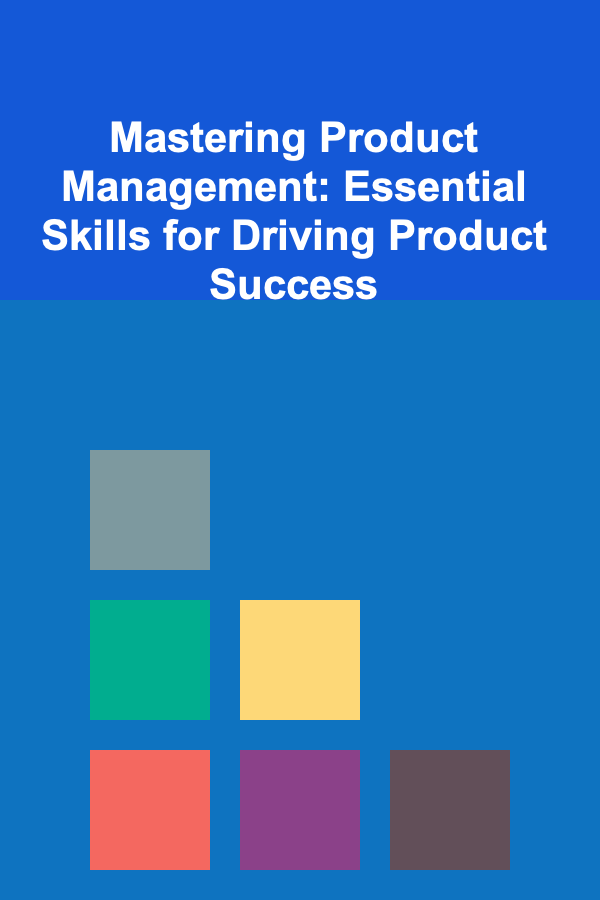
Mastering Product Management: Essential Skills for Driving Product Success
ebook include PDF & Audio bundle (Micro Guide)
$12.99$6.99
Limited Time Offer! Order within the next:

Product management is one of the most dynamic and challenging roles in any organization. As a product manager (PM), you're responsible for the vision, strategy, and execution of a product throughout its entire lifecycle. This requires an ability to balance customer needs, business objectives, technological constraints, and market realities. To succeed, PMs must possess a diverse set of skills, ranging from strategic thinking to tactical execution.
This guide dives deep into the essential skills that every product manager must master to drive product success. Whether you're an aspiring PM or an experienced professional looking to refine your approach, these skills are crucial for navigating the complexities of product management.
Customer-Centric Mindset
At the heart of every successful product is a deep understanding of the customer. PMs must consistently think about how to solve real problems for users and create value that resonates with them. To do this effectively, you need to:
Empathy
Developing empathy is perhaps the most important skill for any PM. This involves not just understanding your customers' needs but feeling their pain points and frustrations. The goal is to make sure that your product genuinely addresses these issues.
Actionable Steps:
- Conduct User Interviews: Regularly speak with customers to gather qualitative insights about their experiences, challenges, and needs. These insights should be incorporated into product development and strategy.
- Observe User Behavior: Use analytics and heatmaps to observe how customers use your product. This can help you identify usability issues and friction points that may not be evident in surveys or interviews.
- Empathy Mapping: Create empathy maps to visualize customer pain points, goals, and emotions. This exercise helps you understand how your product fits into their lives and what improvements are needed.
Continuous Feedback Loops
Product management doesn't end at launch. In fact, it's crucial to establish ongoing feedback loops with customers. Gathering consistent feedback allows you to stay in tune with user needs and iterate your product accordingly.
Actionable Steps:
- Post-Launch Surveys: Send out surveys and questionnaires to users after the product launch to understand what worked and what didn't.
- User Reviews and Ratings: Monitor app store reviews, social media mentions, and community feedback. This can provide invaluable insights into how users perceive your product.
- Customer Support Interactions: Regularly review customer support tickets to identify recurring issues or requests that could inform product improvements.
Strategic Vision and Planning
A great product manager doesn't just focus on day-to-day tasks; they think strategically. You must be able to develop a clear vision for the product and build a roadmap that aligns with both the company's goals and the needs of the users.
Setting Clear Objectives
Before embarking on any product development, it's essential to establish clear, measurable objectives that guide the team. This allows for focused effort and ensures alignment with business goals.
Actionable Steps:
- Define OKRs (Objectives and Key Results): Set high-level objectives for your product and define key results that are specific and measurable. OKRs can provide direction for your product team and keep everyone aligned.
- Create a Product Vision: A well-defined product vision should articulate what the product aims to achieve and how it will impact customers. This vision should inspire your team and provide a long-term view of the product's potential.
- Roadmap Creation: Develop a detailed product roadmap that breaks down strategic goals into smaller, actionable tasks. The roadmap should evolve over time, allowing flexibility to adjust based on new information or market changes.
Market Analysis and Positioning
Understanding the market landscape is crucial for positioning your product effectively. As a PM, you need to perform continuous market research and competitor analysis to ensure that your product stands out.
Actionable Steps:
- Conduct Competitive Analysis: Regularly review your competitors' products to identify gaps or opportunities for differentiation. Use tools like SWOT analysis (Strengths, Weaknesses, Opportunities, Threats) to evaluate how your product stacks up.
- Understand Market Trends: Stay updated on the latest industry trends, emerging technologies, and shifts in consumer behavior. This knowledge will inform your product decisions and help you anticipate future market demands.
- Positioning and Messaging: Develop a clear positioning strategy that differentiates your product from competitors. Ensure that your messaging highlights the unique value proposition of your product and resonates with your target audience.
Prioritization and Decision-Making
In the fast-paced world of product management, you will constantly be bombarded with competing demands. Learning how to prioritize is a fundamental skill that every PM must master to ensure that the team is working on what matters most.
Prioritization Frameworks
Prioritization frameworks can help you make data-driven decisions about what features or projects should be prioritized. These frameworks balance customer value, business impact, and technical feasibility.
Actionable Steps:
- RICE Scoring: Use the RICE (Reach, Impact, Confidence, Effort) scoring model to evaluate potential features or initiatives based on how many people they will reach, the level of impact, the confidence in success, and the effort required.
- MoSCoW Method: Classify features as "Must-have," "Should-have," "Could-have," and "Won't-have" to ensure that you focus on the critical features that will deliver the most value to customers.
- Kano Model: Assess the potential impact of features on customer satisfaction. Features can be categorized as "basic needs," "performance features," and "delighters," helping you identify which ones will have the most positive impact on users.
Managing Trade-offs
PMs often face tough trade-offs. Should you prioritize a high-impact feature that takes a long time to develop, or release a smaller feature quickly that could improve the user experience? Learning how to make these decisions with limited information is crucial.
Actionable Steps:
- Evaluate Costs vs. Benefits: Weigh the cost and potential benefits of each decision. This includes not only financial resources but also time, effort, and the opportunity cost of other initiatives.
- Consult Stakeholders: Engage with key stakeholders (engineering, design, marketing, etc.) to get their input and weigh in on trade-offs. This ensures that decisions are made with a holistic view of the product's needs.
- Data-Driven Decisions: Whenever possible, base decisions on data. This can include user feedback, A/B testing results, and market research, which will provide you with concrete evidence to support your choices.
Execution and Collaboration
Executing a product vision is where the rubber meets the road. PMs must collaborate effectively with cross-functional teams, ensure timely delivery, and mitigate risks to ensure a successful launch.
Cross-Functional Team Leadership
A product manager isn't a decision-maker in isolation; you work with various teams---engineering, design, marketing, sales, and more. It's crucial to lead by influence, ensuring everyone works together toward a shared goal.
Actionable Steps:
- Facilitate Communication: Act as a bridge between different teams, ensuring that everyone is aligned on product goals and priorities. Regular meetings, such as sprint reviews or backlog grooming sessions, help keep everyone informed.
- Empower Teams: Trust your team members and give them the autonomy to make decisions within their areas of expertise. Empowering others fosters ownership and drives innovation.
- Conflict Resolution: In any cross-functional environment, conflicts may arise. As a PM, you should be skilled at managing conflicts and mediating disagreements to keep the project moving forward.
Agile Methodology and Iteration
Product development is rarely linear. Embracing agile practices helps you stay flexible, adapt to changes, and deliver value in incremental iterations.
Actionable Steps:
- Work in Sprints: Break down product development into short sprints (usually two to four weeks). At the end of each sprint, evaluate progress and adjust priorities based on feedback and new insights.
- Continuous Improvement: Use retrospective meetings to reflect on what went well and where improvements can be made. This iterative process helps refine workflows and improve team efficiency over time.
- Release Early, Release Often: Rather than waiting for a perfect product, aim to release minimum viable products (MVPs) or beta versions to gather user feedback early and make necessary adjustments.
Data-Driven Decision Making
Data is the backbone of good product management. Making decisions based on gut feeling alone is risky. Successful PMs rely on data to guide their choices and validate their assumptions.
Analytics and Key Performance Indicators (KPIs)
Tracking the right metrics is essential to understanding product performance and user behavior. KPIs help you gauge whether the product is meeting its goals and where adjustments are needed.
Actionable Steps:
- Define Relevant Metrics: Identify the key metrics that reflect product success, such as user engagement, churn rate, customer satisfaction, or conversion rate. These metrics should align with your product objectives.
- Leverage Analytics Tools: Use tools like Google Analytics, Mixpanel, or Amplitude to track user behavior, conversion funnels, and feature adoption. These tools provide actionable insights that can inform your product strategy.
- A/B Testing: Conduct A/B tests to compare different versions of a feature or user experience. This will help you make evidence-based decisions about what works best for your users.
Conclusion
Mastering product management is a continuous journey. As a PM, you must hone your skills in strategic thinking, customer understanding, prioritization, execution, and data analysis. By focusing on these essential skills, you can lead your product from conception to market success, ensuring that it meets customer needs, drives business value, and stands out in a competitive landscape.
The road to mastering product management is challenging, but by embracing these key skills, you can build products that truly make an impact.
Reading More From Our Other Websites
- [Home Pet Care 101] How to Make Homemade Pet Treats for Your Furry Friend
- [Stamp Making Tip 101] How to Create Durable Foam Stamps for Kids' Art Projects
- [Personal Finance Management 101] How to Protect Your Finances from Inflation and Economic Uncertainty
- [Home Staging 101] How to Stage a Small Apartment for Maximum Appeal
- [Home Staging 101] How to Stage Your Home for Seasonal Buyers
- [Star Gazing Tip 101] How to Use a Red Light Flashlight to Preserve Night Vision While Star‑Gazing
- [Screen Printing Tip 101] Best Custom Screen Printing Solutions for Luxury Apparel Brands
- [Personal Investment 101] 5 Ways to Build Passive Income with Deep Learning
- [Simple Life Tip 101] The Best Simple‑Life Cleaning Schedule for Busy Couples
- [Organization Tip 101] How to Use Password Managers to Keep Your Accounts Secure

How to Build a Family Garden as a Fun Activity
Read More
How to Create a Pet-Proof Home for a Safe Living Space
Read More
How to Save Space in Your Home by Using Furniture with Built-In Storage
Read More
How to Store Printed Photos Safely
Read More
How to Practice Acupressure for Self-Care
Read More
How to Cultivate a Positive Body Image
Read MoreOther Products

How to Build a Family Garden as a Fun Activity
Read More
How to Create a Pet-Proof Home for a Safe Living Space
Read More
How to Save Space in Your Home by Using Furniture with Built-In Storage
Read More
How to Store Printed Photos Safely
Read More
How to Practice Acupressure for Self-Care
Read More